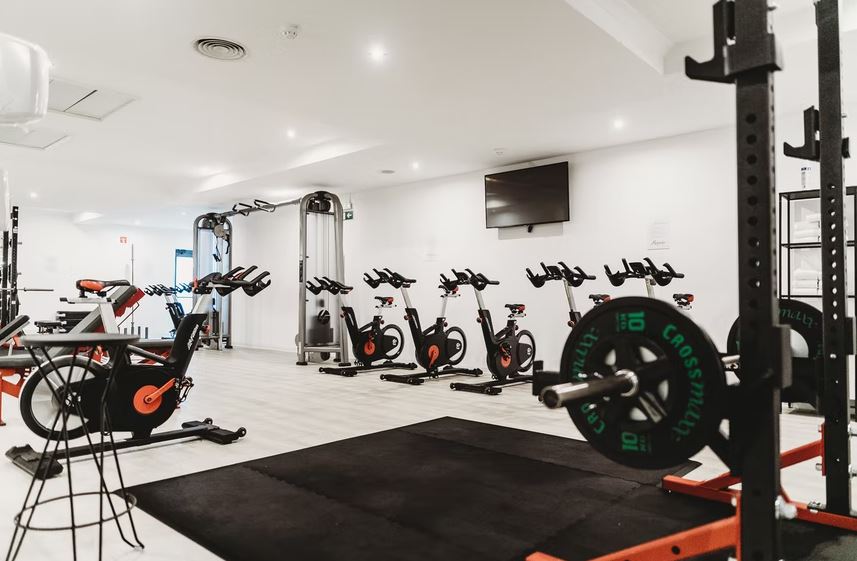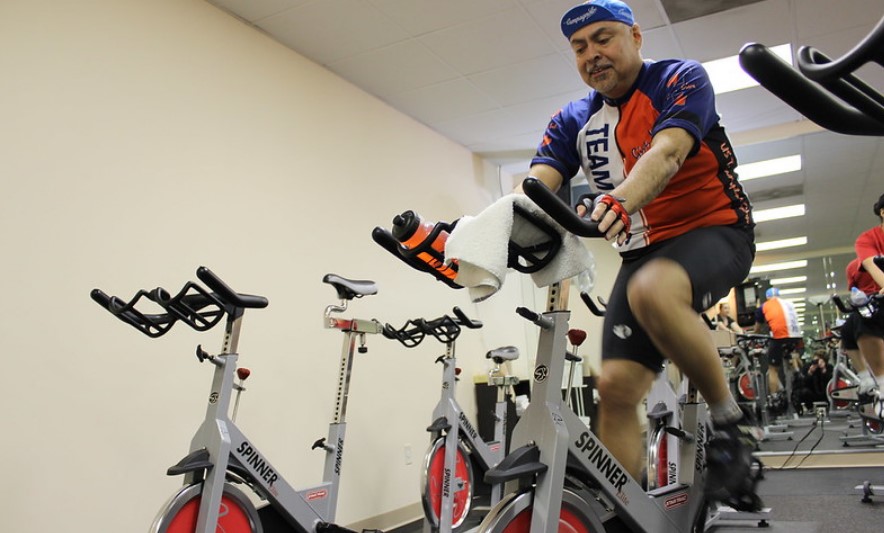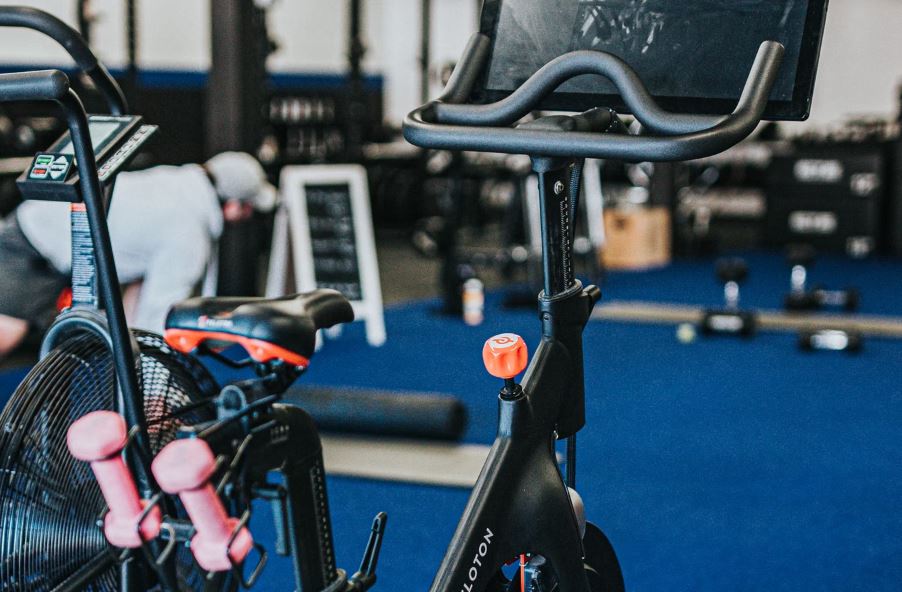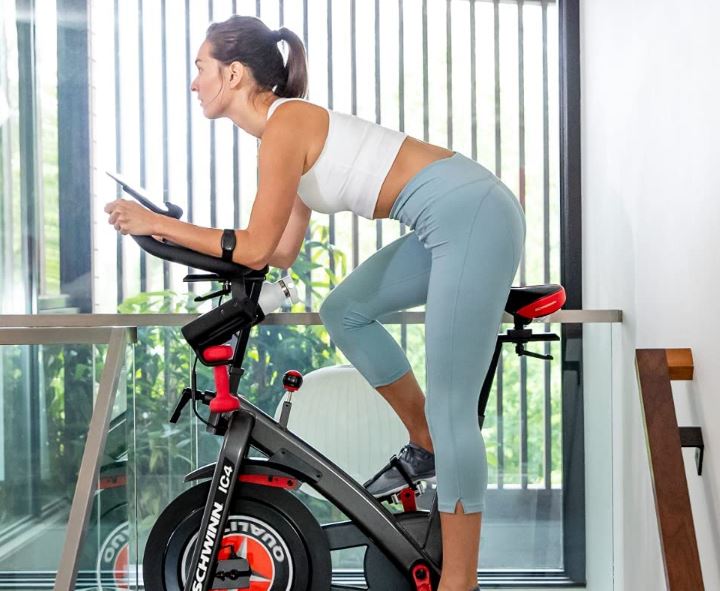Exercise bikes are quite effective for low-impact cardio exercises. By using an exercise bike, you may enhance your cardiovascular and aerobic fitness, burn calories, build stronger legs, and elevate your mood—all while putting less strain on your joints and avoiding the dangers of riding a bike in traffic.

Traditional stationary bikes and spin bikes, which are more commonly known as indoor cycles, are the two main types of workout bikes. Although each form of exercise bike has advantages and disadvantages, both offer the same general advantages. Continue reading the article to learn the distinction between stationary bikes and spin bikes or if you want to know whether you should use a stationary bike or a spin bike at the gym, or if you want to buy one for your home gym.
Spin Bikes & Stationary Bikes: Key Differences
The typical upright workout bikes you’ve probably seen at a gym are known as stationary bikes. They have a console and frequently already have programs loaded. By choosing a different level, you may change the resistance, and you can also change the intensity of the workout by pedalling more quickly or slowly. Direct contact friction is typically utilized on stationary cycles.
The exposed flywheel on spin bikes, also known as indoor cycles, is frequently much heavier than the flywheel on a stationary bike even if they may not have a console. The majority of indoor cycles use magnetic or friction resistance. The bikes include a dial or knob to adjust the friction resistance, which relies on felt or rubber pads resting on the flywheel to prevent it from moving when you pedal. Similar to stationary bikes, magnetic resistance provides distinct levels of resistance.
Exercise Intensity: Spin Bikes vs. Stationary Bikes
In general, a spin cycle will provide you with a more intensive workout than a stationary bike. Compared to stationary cycles, spin bikes need more muscle activity overall, including some of the upper body and core. A stationary bike workout mostly targets the legs. Additionally, their flywheel is heavier. For climbs and extremely difficult efforts, you can also stand on a spin bike, but not on a stationary bike.
Since most spin classes and indoor cycling workouts are designed to be high-intensity robust attempts to enhance cardiovascular fitness, compared to most stationary bike workout sessions, which are intended to be more moderate-intensity aerobic initiatives that enhance markers of wellbeing, the essence of the exercises also tend to vary. Of course, you may use a spin bike for a low-intensity workout and a stationary bike to push yourself to the limit, but the two bikes’ principal functions are often somewhat dissimilar.
The Resistance Between Stationary Bikes & Spin Bikes
As previously indicated, a variety of mechanisms may be used to provide friction on stationary bikes and spin bikes. The highest maximum resistance on friction resistance spin bikes, which use felt pads, is reached when the felt pad is completely against the flywheel during a full stop. Due to the ongoing rather than specific flexibility, they also have an endless number of levels. Friction resistance spin bikes do have some drawbacks. Over time, the felt pads may need to be changed because of wear and tear.
Magnetic resistance spin bikes are more accurate. They also operate more quietly and smoothly, although you are only able to use the bike’s levels. The gradations between levels may be too great for you to dial in the precise level of effort you desire, or you may find the lightest level to be too challenging and the hardest level to be too difficult.
On stationary cycles, the direct contact resistance can wear out and is comparable to friction resistance. Furthermore, there is no dial on the bikes that you can spin to micro-adjust the resistance. Instead, you are forced to choose from a set of numbered levels.
Related:
Muscles Worked: Spin Bikes vs. Stationary Bikes
The quads, hamstrings, and calves are the main muscle groups targeted by both types of exercise bikes, with the glutes receiving less attention. Spin bikes help to some extent with back, core, and shoulder strength. A spin bike becomes a total-body exercise when you stand on it. Given that your torso is supported by the seat, recumbent bikes provide the least core stimulation.
Adjustability Between Stationary Bikes & Spin Bikes
The majority of exercise bikes allow for adjustments to the resistance, handlebar height, and seat height. The seat and handlebars of spin bikes can frequently be moved forward and backward, and they have typically higher resistance levels as compared to stationary bikes.
Calories Burned: Spin Bikes vs. Stationary Bikes
The amount of calories you burn when using an exercise bike depends on the intensity and length of your workout, irrespective of the sort of exercise bike you ride. You’ll burn more calories during a spin bike workout compared to a comparable session on a stationary bike since, generally speaking, the energy expenditure is higher on a spin bike or indoor cycle than it is on a stationary bike. Spin bikes have a heavier flywheel, a higher effort ceiling, and call for more muscular engagement. It’s also crucial to remember that most spin bike workouts are by nature more intense than aerobic stationary bike routines.
Spin Bikes vs Stationary Bikes: Console
Many spin bikes lack a console, despite the fact that there are an increasing number of well-liked indoor cycles with smart technology and built-in consoles. Stationary bikes, on the other hand, feature a built-in console. The console normally records data about your workout, like the duration, intensity, calories burnt, distance traveled, and heart rate. There might also be pre-built fitness plans.
With touch screens and app connectivity, more expensive indoor cycles like the MYX II Plus, Peloton, Schwinn IC4, and Echelon bikes give all the advantages of a stationary bike console in addition to extras like video streaming. Additionally, you can stream engaging classes to increase your motivation.
Spin Bikes vs. Stationary Bikes: How They Compare To Outdoor Cycling?
The riding position on spin bikes or indoor cycles is intended to be more similar to that of an outdoor bike, with a greater forward lean. The riding stance on stationary bikes is less muscular and more straight. On a spin bike as opposed to a stationary bike, the pedaling stroke is also intended to feel more natural. An indoor bicycle will feel even more like an outdoor bicycle if it has chain-drive systems rather than belt drives.
Spin Bikes vs. Stationary Bikes: Price
Both stationary bikes and spin bikes come in a wide range of pricing points, based on the build quality, type of friction, innovation, and bells and whistles. Spin bikes are pricier, whereas stationary bikes for home use are typically less expensive. However, if you’re prepared to purchase indoor cycles and spin bikes without touchscreen consoles, you can locate them for a reasonable price.
Risk of Injury
The spin cycle really has a lower injury risk than a regular upright bike when it comes to injury risk when we look at how the machine is set up. This is due to the flywheel’s ease of usage, which keeps the bike moving constantly and lessens the strain on the joints. As a result of this wider variety of movement patterns, those who spin extremely intensely are more likely to spin quicker and may even be standing on the bike, which increases your risk of injury. It is important to remember that spinning while standing will always place you at a larger risk for injury than spinning when sitting. Your risk of damage is quite low if you just use the spinning bike to sit and spin. Back pain from leaning forward more frequently on this kind of cycle may be what you discover you experience the most of.
Spin Bikes vs. Stationary Bikes: The Bottom Line
You can get a good cardio workout on either sort of exercise bike, whether it’s a stationary bike or an indoor cycle. However, a spin bike will probably be more effective for you if you want to really improve your physique and get a more challenging workout. However, a stationary bike may be more affordable and simpler to operate if you’re searching for a more basic, beginner-friendly piece of fitness equipment for cardiovascular training. Each bike has its own pros and cons. However, you can check the specifications of the spin bike and stationary bike and choose to go for one that best suits your requirements, budget, and preferences.



